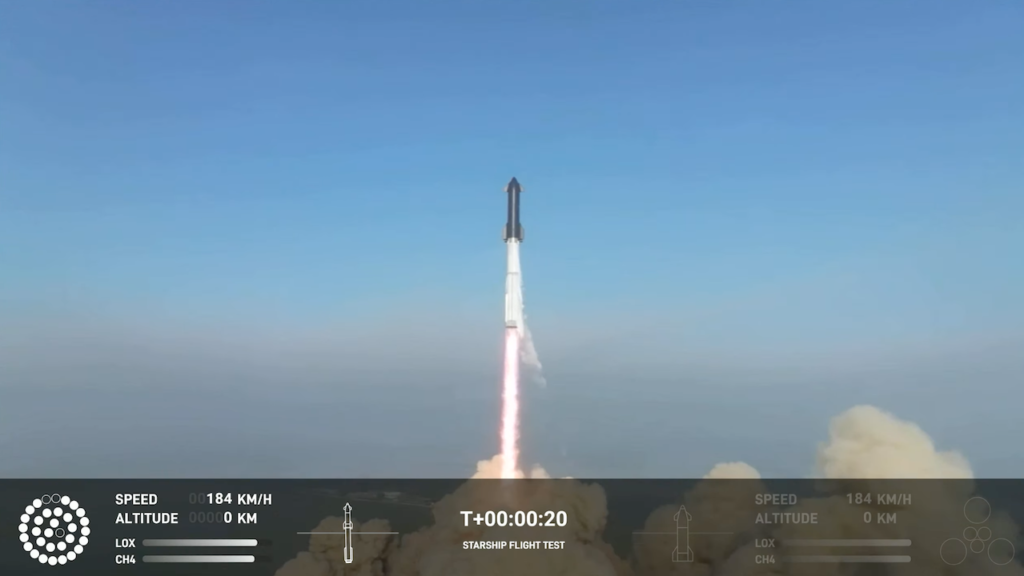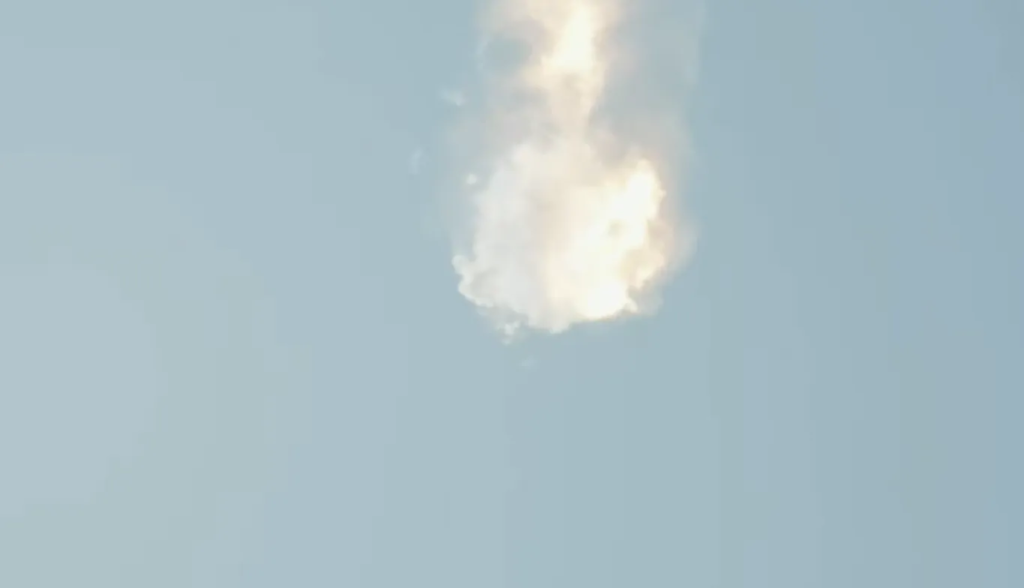
The Damage To Stage 0 After Starship’s First Launch
After years of waiting, yesterday we watched as SpaceX attempted the first integrated test flight of the Starship launch vehicle. However, Starship was not the only thing being tested yesterday. Arguably as important as the launch vehicle itself, the stage 0 infrastructure was also put to the true test for the first time.
Here we saw 33 Raptor engines firing at full thrust straight onto the concrete below. Combine this power with the almost 8 seconds of time that Starship was on top of the mount and the results were explosive. This not only destroyed the ground right under the engines but shot projectiles hundreds of meters in every direction.
Thankfully, despite this explosive start, Starship was still able to lift off and continue in flight for a few minutes. This being said, it’s possible that those initial projectiles caused some damage that sealed the fate of Starship’s first launch. Here I will go more in-depth into the extent of damage to the pad, possible solutions SpaceX might look into, what to expect in the coming months, and more.
Stage 0 Damage

Stage 0 is the main pad infrastructure that supports the Starship launch and catch operations. This includes the launch tower, orbital launch mount, propellant tanks, and any other ground system helping Starship complete a launch. With SpaceX’s plans for rapid reusability, these systems similar to the rocket need to be ready soon after launch for the next attempt. Before this launch, SpaceX decided to hold off on a few key pieces of the Stage 0 system that ended up causing some significant damage. You can see when the clock hits 0, Starship’s engines ignite and for around 8 whole seconds the rocket stays on the pad before finally lifting off. Then, as it starts to clear the tower, debris can be seen flying hundreds of feet into the air.
In terms of pad damage, the first and most obvious is underneath the orbital launch mount. Images show a massive crater wide enough and deep enough to cave in under the main mount supports. What was once reinforced concrete is now the start of a trench due to the thrust of 33 Raptor engines. This one issue was also the cause of many other problems related to Stage 0. For example, the propellant tank farm sustained some significant dents and outer shell damage from the launch mount concrete projectiles. This also brought up additional concerns about these tanks for one being so close to the mount, and two being vertical rather than horizontal. This layout puts them right in the way of any projectiles and thrust of the most powerful rocket in the world. The amount of material and how fast and far it flew was immense. A video provided by SpaceX puts this in perspective soon after launch. On the right side toward the water, after Starship lifts off, a ton of concrete and material can be seen splashing into the water hundreds of feet away.
You have to imagine if the material made it all the way out there, it could easily fly into nearby infrastructure like the vertical propellant tanks, and any other structure. Funny enough, SpaceX knew that the current setup and lack of a flame diverter in particular could be problematic. Back in late 2020, Elon Musk tweeted saying, “Aspiring to have no flame diverter in Boca, but this could turn out to be a mistake”. Even a water deluge system would have helped the problem however SpaceX wanted to get this launch off as soon as possible and decided to forgo the extra systems.
One final thing that could have been damaged is the Starship vehicle itself. Right after liftoff, 3 engines were not providing thrust according to the company’s graphic, later in the launch this would increase to 6 before the explosive ending. Many believe that the significant thrust and the proximity of Stasrhip to the ground for an extended period of time allowed concrete debris to shoot up in the air and damage either the engines themselves or any supporting systems. On the bright side, Starship managed to clear the tower and continue to gain altitude. If Starship would have blown up on the pad the damage would have been much worse.
Future Plans

One thing is very clear from the results and various damage to Stage 0, before SpaceX attempts its next Starship launch, they will need to have come up with a solution for the thrust and power of the 33 Raptor engines. Right after the launch Elon tweeted saying, “Congrats @SpaceX team on an exciting test launch of Starship! Learned a lot for next test launch in a few months.” Based on this it’s clear that the company wants to get the next Starship up as soon as possible. However, there might be more work than initially expected.
There really is one main way to solve the Raptor engine thrust issue which is to divert it. A flame diverter is an angular construction beneath a launch pad that diverts the rocket’s exhaust to the side. The core problem of the thrust hitting the concrete below in Starship’s case is not necessarily the heat, it’s the force at which the Raptor exhaust is hitting the ground. It’s so powerful that it literally destroys it before sending it flying a few hundred feet.
Flame trenches are also an option and are quite popular for other rockets. For example, the Space Shuttle used a flame trench built with concrete and refractory brick that bisected the pad at ground level. It was 490 feet long, 58 feet wide and 42 feet deep. The flame deflector system includes an inverted, V-shaped steel structure covered with a high-temperature concrete material five inches thick that extends across the center of the flame trench. One side of the “V” receives and deflects the flames from the orbiter main engines; the opposite side deflects the flames from the solid rocket boosters. There are also two movable deflectors at the top of the trench to provide additional protection to shuttle hardware from the solid rocket booster flames.
The issue with a flame trench in SpaceX’s case is the proximity to the water and some external factors. It may not be possible to dig a massive trench capable of properly dispersing the thrust from the engines. Another option that we could see in the future could be heightening the Orbital Launch Mount. The further away from the ground the better. This in combination with a proper diverter would significantly help the issues we saw on yesterday’s attempt.
Another example is the Space Launch System which we recently saw launch. Measuring approximately 57 feet wide, 43 feet high and 70 feet long, the deflector’s north side is slanted at about a 58-degree angle and diverts the rocket’s exhaust, pressure and intense heat to the north at liftoff. “The thick steel plates are designed to withstand the exhaust and heat from several launches,” said Nick Moss, EGS pad deputy project manager. “There is flexibility of maintenance; as steel plates closest to the exhaust plume begin to erode, they can be replaced.” Not only this, but water pipes used for sound suppression were installed on the crest of the main flame deflector. At launch, thousands of gallons of water flow from a tank through the pipes and out to cool the main flame trench and absorb and re-direct shock waves while reducing sound levels that can damage the vehicle and surrounding structures. Another system that SpaceX could install to help with the exhaust.
Approximately 100,000 heat-resistant bricks, in three different sizes, were secured to the walls using bonding mortar, and where required, steel plate anchors. In areas where significant temperature and pressure will occur, steel plate anchors were fastened into the walls at intervals to reinforce the brick system. As far as the future of Stage 0, the question now becomes what will SpaceX begin working on and how long will it take. Assuming they begin working on a proper flame diverter, a few months would be ambitious. There also could be some different changes that temporarily fix the issue while they continue to test Starship and try to get it into orbit. Something we will have to keep an eye on in the coming months.
Recently, the company released some more information on yesterday’s attempt. At 8:33 a.m. CT, Starship successfully lifted off from the orbital launch pad for the first time. The vehicle cleared the pad and beach as Starship climbed to an apogee of ~39 km over the Gulf of Mexico – the highest of any Starship to-date. They said that the vehicle experienced multiple engines out during the flight test, lost altitude, and began to tumble. The flight termination system was commanded on both the booster and ship causing the two main explosions at the end of the launch. As is standard procedure, the pad and surrounding area was cleared well in advance of the test, and they expect the road and beach near the pad to remain closed until tomorrow. They finished by saying, “With a test like this, success comes from what we learn, and we learned a tremendous amount about the vehicle and ground systems today that will help us improve on future flights of Starship.”
Conclusion
SpaceX has quite a bit of work ahead of them after yesterday’s Starship launch attempt. Besides work on Starship itself, it’s clear that work needs to be done under the launch mount to try and handle the extreme exhaust from the most powerful rocket in the world. We will have to wait and see how it progresses and the impact it has on the space industry.